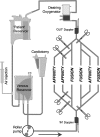Air Transmission Comparison of the Affinity Fusion Oxygenator with an Integrated Arterial Filter to the Affinity NT Oxygenator with a Separate Arterial Filter
- PMID: 26357789
- PMCID: PMC4566832
Air Transmission Comparison of the Affinity Fusion Oxygenator with an Integrated Arterial Filter to the Affinity NT Oxygenator with a Separate Arterial Filter
Abstract
Arterial filters used in the extracorporeal circuit (ECC) have been shown to minimize cerebral injury by capturing particulate matter and microbubbles. We clinically use the Affinity NT oxygenator with an Affinity arterial filter attached ("Affinity system"). The new Affinity Fusion oxygenator ("Fusion") incorporates integrated arterial filtering. Our aim was to determine if the Fusion oxygenator was as safe as the Affinity system in terms of relative microbubble transmission of introduced air. A recirculating in vitro circuit primed with blood was used to compare the Fusion with the Affinity system. Microbubbles were detected using a GAMPT BC100 Doppler in the oxygenator-arterial filter outflow line. Measurements were taken 1 minute before and 3 minutes after bolusing 30 mL air proximal to the venous reservoir while altering pump flow rates (3 L/min; 5 L/min). Both the Fusion and Affinity system transmitted microbubbles during air injection. Microbubble volume transmitted at 5 L/min pump flow was significantly greater than at 3 L/min in both systems. The Fusion tended to transmit fewer bubbles, less bubble volume, and smaller sized bubbles than the Affinity system. Under the parameters of this in vitro study, the Affinity Fusion oxygenator with an integrated arterial filter is as safe as the Affinity NT oxygenator with a separate arterial filter in terms of microbubble transmission. However, more research is needed to confirm this study's findings and generalizability to the clinical environment. As both oxygenator-arterial filter systems transmitted microbubbles during air introduction, it is important to develop strategies to minimize microbubble entry into the ECC.
Conflict of interest statement
The senior author has stated that the authors have reported no material, financial, or other relationship with any healthcare-related business or other entity whose products or services are discussed in this paper.
Figures




Comment in
-
Working toward Best Practice: Microbubble Filtration and Patient Safety During Extracorporeal Circulation.J Extra Corpor Technol. 2015 Jun;47(2):125-7. J Extra Corpor Technol. 2015. PMID: 26413712 Free PMC article. No abstract available.
-
Response to Letter "Working toward Best Practice: Microbubble Filtration and Patient Safety during Extracorporeal Circulation" by Daniel P. Herbst.J Extra Corpor Technol. 2015 Jun;47(2):128-9. J Extra Corpor Technol. 2015. PMID: 26413713 No abstract available.
-
Technology Use and Patient Safety: At the Intersection of Change.J Extra Corpor Technol. 2016 Dec;48(4):204-205. J Extra Corpor Technol. 2016. PMID: 27994263 Free PMC article. No abstract available.
References
-
- Hammon JW, Stump DA, Kon ND, et al. . Risk factors and solutions for the development of neurobehavioural changes after coronary artery bypass grafting. Ann Thorac Surg. 1997;63:1613–1618. - PubMed
-
- Abu-Omar Y, Balacumaraswami L, Pigott DW, Matthews PM, Taggart DP.. Solid and gaseous cerebral microembolisation during off-pump, on-pump, and open cardiac surgery procedures. J Thorac Cardiovasc Surg. 2004;127:1759–1765. - PubMed
-
- Pugsley W, Klinger L, Paschalis C, Treasure T, Harrison M, Newman S.. The impact of microemboli during cardiopulmonary bypass on neuropsychological functioning. Stroke. 1994;25:1393–1399. - PubMed
-
- Taggart DP, Bhattacharya K, Meston N, et al. . Serum S-100 protein concentration after cardiac surgery: A randomized trial of arterial line filtration. Eur J Cardiothorac Surg. 1997;11:645–649. - PubMed
-
- Medtronic Inc. Affinity Fusion Oxygenation System, 2013. Available at: http://www.fusionoxygenator.com. Accessed June 4, 2014.
Publication types
MeSH terms
LinkOut - more resources
Full Text Sources
Research Materials
